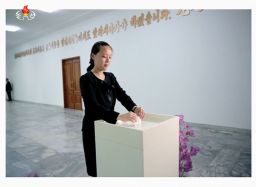Story highlights
Local elections held Sunday to approve provincial, city and county leaders
Voters can choose to vote against the candidate but no one does
North Korea’s elections are over, the ballots are counted and we have a not-so-surprising result.
With 100% of participants approving the candidates, the word ‘landslide’ hardly seems sufficient.
Turnout was an impressive 99.97% of eligible voters, coincidentally, the exact same turnout percentage to two decimal places as the previous local elections in 2011.
For the Democratic People’s Republic of Korea, democracy is too serious a matter to leave to chance.
Supreme Leader Kim Jong Un cast his vote, as did his 28-year-old sister.
Kim Yo Jong’s profile has been rising since 2014 and she is now believed to be head of North Korea’s Propaganda and Agitation Department.

How North Korea votes
The candidates are preselected by the ruling party, and there is only one name on the ballot – the voter does not mark the paper, just picks it up and drops it in the appropriate box.
It is possible to register rejection of a candidate by dropping the ballot in a different box. But the 100% approval vote suggests no one in the entire country took advantage of that option.
These local elections are held every five years to select deputies to local people’s assemblies at provincial, city and county levels.
These bodies are tasked with deliberating and approving local economic plans and budgets as well as appointing and dismissing some local officials.
However, when voting in their own assemblies they are considered to be as unanimous as the voters who elected them in the first place.
Who doesn’t vote?
According to the DPRK constitution, all persons over the age of 17, except those disenfranchised by court decision or legally insane, have the right to vote. That would indicate an electorate of a little over 17 million people, based on 2008 census data. So who were the 0.03%, some 5,000 souls, who failed to exercise their duty?
Age or illness is no excuse – mobile ballot boxes were provided for those physically unable to make the trip to the polling station, according to KCNA. The government news agency says only those on foreign tour or working at sea were unable to vote.
The compulsory universal turnout, analysts and defectors say, serves another important purpose for the government.
The election acts as an unofficial census, allowing the government to discover who has defected or otherwise gone missing. And that spells big trouble, not only for the missing voter, but also for his or her family.
North Korea: We’re not interested in Iran-style nuclear talks

